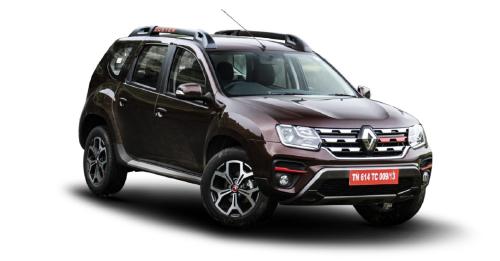
Renault Duster 1.3L Turbo Review: First Drive
A look at the history of the Renault brand in India is enough to realise the importance of the Duster, not just in establishing the Renault brand in India but also popularising SUVs in the Indian market. With its handsome design, great practicality, and terrific

The Duster did wonders in terms of both establishing the Renault brand and popularizing SUVs in India. But, with competition taking the lead since, can a new engine claw back some lost ground?
A look at the history of the Renault brand in India is enough to realise the importance of the Duster, not just in establishing the Renault brand in India but also in popularising SUVs in the Indian market. With its handsome design, great practicality, and terrific suspension, the Duster’s success set the tone for the success that SUVs would go on to achieve in the Indian market. But, in the eight years since its original launch, the competition in the mid-size SUV segment has become incredibly intense, with the Duster being overshadowed by its rivals. So, in response, Renault has decided to give the Duster some mild visual enhancements and a brand-new engine. The question is whether that’s enough to put the Duster back in the game.

NIP & TUCK
The Duster was a pretty handsome SUV when it was launched in 2012, and, to an extent, it still is – the design has aged quite well. It still looks contemporary and attractive. In its latest version, the Duster features some design highlights that are marked by red detailing to stand out. This includes red touches on the front grille, bumper, and wheels, along with new badging, and a new alloy wheel design. It’s also available in different colours – the Caspian blue shade of our test car is a particularly attractive colour.
Unlike the exterior design, the Duster’s interior is beginning to show its age – you can tell that this an eight-year-old car. Compared to its rivals, the Duster’s interior is pretty basic and there are hard plastics everywhere. In short, it definitely feels outclassed by more recent rivals, such as the Hyundai Creta and Kia Seltos. But that’s not to say that the Duster’s interior has lost all its functionality – it still offers a decent amount of space for passengers and has a large 475-litre boot.
Equipment-wise, the Duster does get dual airbags, ABS, and EBD as standard across the range, but misses out on equipment that its rivals offer, such as a sunroof, xenon or LED lights, and ventilated seats, to name a few.

ACE UP ITS SLEEVE
Ever since its launch in 2012, the Duster has offered class-leading ride quality, something which continues to be a highlight in this latest version. Irrespective of the road conditions and speed you’re carrying, the suspension setup of the Duster is simply flawless, which makes its cabin an extremely comfortable place to be in. It also imbues you with a sense of security and safety while cruising at high speeds on the highway. The high-speed stability of the Duster is fantastic, and I’d go so far as to say that the ride quality remains amongst the best in the Indian market, particularly in terms of tackling broken roads.
NEW BLOOD
However, the real treat in this latest avatar is its brand-new engine – a 1.3-litre turbocharged petrol unit. With the 1.3-litre motor, the Duster now features almost 50% more power than the old 1.5-litre diesel unit. The new engine, with its 153bhp, is a fantastic unit. Despite being turbocharged, the engine’s response is terrific – it delivers power in a linear way and revs freely to the redline.

The Duster has always been a fun car to drive, but the added power really kicks up the performance and fun factor. The quick mid-range and top-end response means that cruising at three-digit speeds is a breeze. Also, its instant in-gear acceleration makes tackling tight gaps in traffic quite easy.
However, the Duster’s added power also exaggerates one of its main problems – the steering kickback, which continues to be a real annoyance for the driver. While the suspension and body control of the Duster makes it a breeze to drive on bad roads, the steering kickback can be very tiring indeed. The kickback is even more tiring in the hills, and this unfortunate trait has only been enhanced by the Duster’s newfound turn of speed.

That apart, with the new engine, the Duster has become a lot more engaging. It remains a phenomenal driver’s car, with a high seating position, easy visibility because of its large glasshouse, and instant engine response. The terrific suspension setup and added power now make it a much better driver’s car, with a chassis that can certainly handle the additional power. In short, with its large boot, great suspension and comfort, the Duster continues to cover the basics extremely well.
The Duster’s weak points, then, are its interior design, quality, and feature-list – not to mention that annoying kickback. However, it continues to offer great value for money, given that its priced between `10.49 and 13.59 lakh. At that price, the Duster still makes a strong case for itself as an SUV that does exactly what it’s advertised to do. It is old-school – but, with a modern heart, remains fun to drive.
Also read - Renault Duster 1.3 Turbo petrol launched at Rs 10.49 lakh
Engine: 1,330cc / 4-Cylinders / Turbocharged
Fuel: Petrol
Transmission: 6-Speed Manual / 7-speed CVT / Front-Wheel Drive
Power: 154bhp @ 5,500rpm
Torque: 254Nm @ 1,600rpm
Price: ₹10.49 - 13.59 Lakh (Ex-showroom)
X-Factor: With the new 153bhp engine, the Duster is one hell of a pocket rocket, but watch out for that steering kickback!
| Pros • Fantastic engine • Amazing ride quality |
Cons |
Renault Duster [2020-2022]




























Write your Comment on